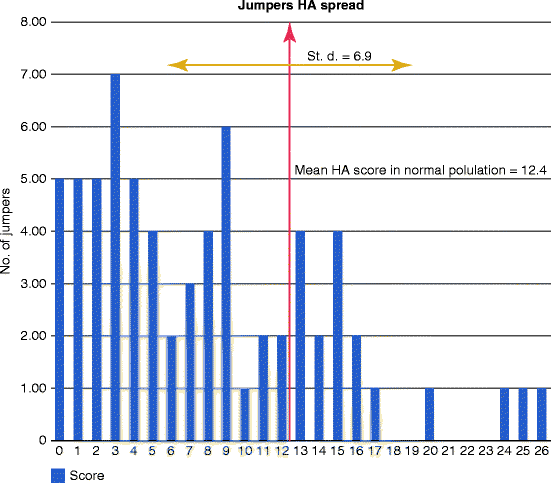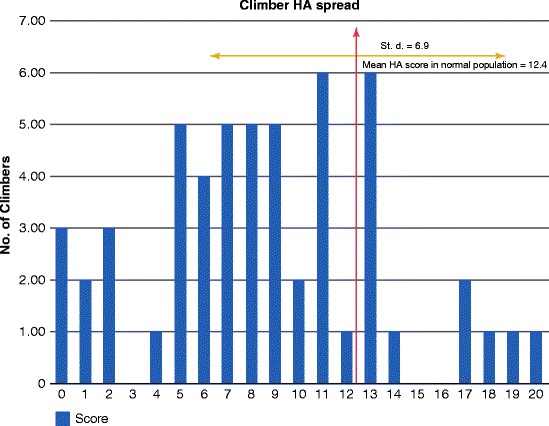Minimum
Maximum
Mean
Age (years)
21
56
33
Years climbing
1
>20
>7
Climbing grades – rock
12
29
23
Climbing grades – alpine
2
6+
5
Professional vs. amateur
8 professional
41 amateur
Injured climbers
47 %
?
Gender
10 % (female)
90 % (male)
Marital status
51 % single
49 % married
Table 14.2
BASE jumpers’ demographic and injury findings
Minimum | Maximum | Mean | |
|---|---|---|---|
Age | 21 | 68 | 34 |
Gender | 59 males (87 %) | 9 females (13 %) | |
Martial status | 39 single (58 %) | 29 married (42 %) | |
Time BASE jumping (years) | 0.5 | 17 | 5.8 |
Total no. of jumps | 12 | 2,300 | 286 |
Injured jumpers | 28 injured (42 %) | 40 not injured (58 %) | |
Severity (AIS) | 2 | 5 | 3.1 |
TCI scores are summarized in Table 14.3. Mountaineers and BASE jumper personality measures differed significantly from age-matched controls; they had higher NS and SD scores, and lower HA and ST scores. In addition, BASE jumpers had lower scores on RD. Overall there was no difference between male and female scores in the BASE jumper population, and there were insufficient females in the mountaineer population to determine whether there were any gender differences. There was no difference in personality variables between mountaineers and BASE jumpers. Interestingly, all TCI scores, except for HA, were distributed relatively normally. As Figs. 14.1 and 14.2 show, HA scores had a markedly skewed distribution. In particular, a significant proportion of BASE jumpers had extremely low HA scores; 40 % have a score of 4 or less.


Table 14.3
Climber (n = 49) and BASE jumpers (n = 68) compared with normative population (n = 181) TCI-235 score means (and SD)
NS*** | HA*** | RD | P | SD** | C | ST*** | |
|---|---|---|---|---|---|---|---|
Climbers | 21.6 (5.2) | 9.1 (4.7) | 14.1 (4.4) | 5.0 (1.5) | 35.5 (5.0) | 34.1 (4.6) | 11.0 (6.7) |
Base jumpers | 22.8 (5.7) | 7.9 (6.3) | 13.8 (4.8)** | 5.5 (1.4) | 33.4 (6.7) | 33.7 (5.6) | 12.7 (7.0) |
Controls | 19.0 (5.8) | 12.4 (6.9) | 15.6 (4.3) | 5.7 (2.1) | 32.0 (7.0) | 33.6 (6.7) | 18.7 (6.3) |

Fig. 14.1
HA scores in BASE jumpers

Fig. 14.2
HA scores in climbers
In mountaineers, the Spearman correlation coefficients noted a significant inverse relationship between cooperativeness and the total number of accidents (−0.313, p < 0.05) and severity of accidents (−0.475, p < 0.05); in this group, there was no significant correlation between other personality traits and number or severity of accidents. Interestingly, there was no association between personality traits and injury measures in the BASE jump group, with the strongest Spearman’s r = −0.09.
Implication of Research Findings
Overall, when compared to age-matched control populations, mountaineers and BASE jumpers scored higher on the temperament measure of NS and the character measure of SD and lower on the temperament measure of HA and the character measure of ST, with only BASE jumpers scoring lower on the temperamental measure of RD. However, the relatively large variation evident in the standard deviations across the measures of temperament and character suggests that there is not a tightly defined personality profile among mountaineers and BASE jumpers, and that factors other than personality are also likely to contribute to engagement in these sports. Such factors may include opportunity and access to the natural climbing environment, peer influence, increased popularity, media attention, and commercialization of these activities.
There is a high correlation between Zuckerman’s SS and Cloninger’s NS scales [25], and, therefore, the finding of high NS in the research population is consistent with the previously demonstrated relationship between SS and participation in risk-taking sports [12–18]. According to Cloninger’s model of personality, high novelty seekers enjoy exploring unfamiliar places and situations. They are easily bored; try to avoid monotony and so tend to be quick-tempered, excitable, and impulsive; and enjoy new experiences and seek out thrills and adventures, even if other people think that they are a waste of time. NS is reinforced by a constellation of genetically determined neurotransmitters, particularly those in the dopamine/pleasure system [26, 27]. High NS and SS suggests that mountaineers and BASE jumpers have lower levels of circulating dopamine and therefore may be in a state of under arousal, which may in turn contribute to engagement in risk-taking sports.
There is also a correlation between Eysenck’s neuroticism (N) and Cloninger’s HA scales [25], and so the findings of low HA in our population are consistent with the finding of Freixanet’s study, which found that elite alpinists scored lower on N compared to controls and other mountaineers [14]. Forty percent of BASE jumpers and 17 % of mountaineers had extremely low HA scores. In a normal population, around 5 % have HA scores of 4 or less. The eight- and threefold increase in BASE jumpers and mountaineers, respectively, suggests that a large proportion have a temperament profile characterized by low HA. HA consists of a heritable bias in the inhibition or cessation of behaviors, while high scores are positively correlated with pessimistic worry in anticipation of future problems, passive avoidant behaviors such as fear of uncertainty and shyness of strangers, and rapid fatigability. The findings of low HA are therefore not surprising or counterintuitive, as individuals with low scores on this dimension are described as carefree, relaxed, daring, courageous, composed, and optimistic even in situations which worry most people. These individuals are described as outgoing, bold, and confident. Their energy levels tend to be high, and they impress others as dynamic, lively, and vigorous. The advantages of HA are confidence in the face of danger and uncertainty, leading to optimistic and energetic efforts with little or no distress. The disadvantages are related to unresponsiveness to danger, which can lead to foolhardy optimism [21].
Stay updated, free articles. Join our Telegram channel

Full access? Get Clinical Tree








